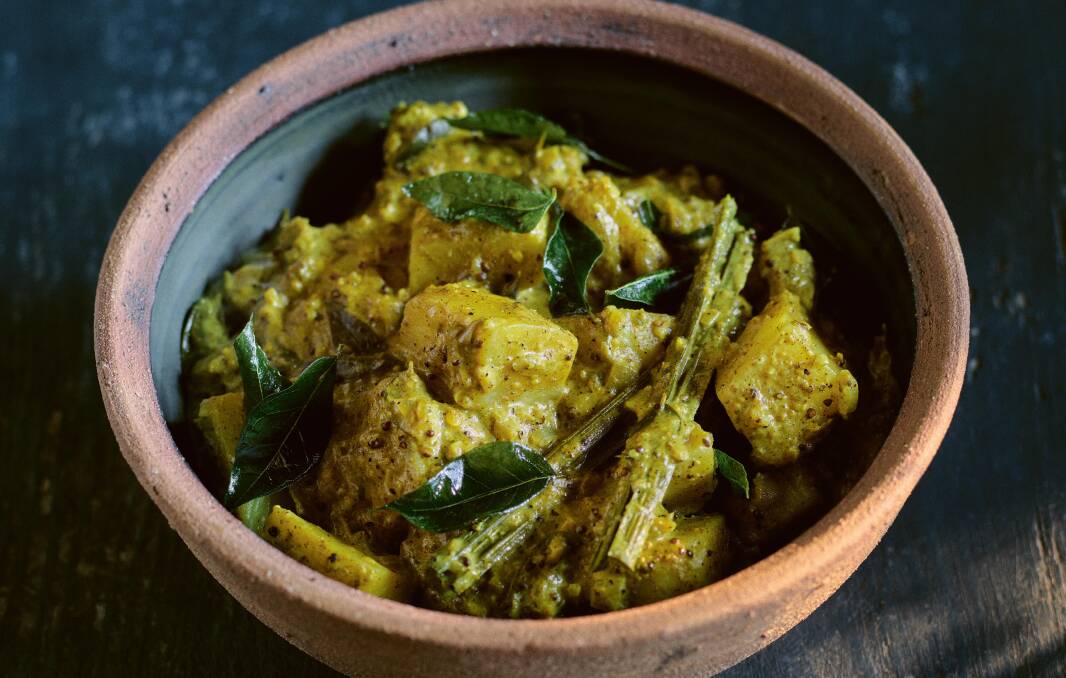
Sitting on the edge of the Indian Ocean, just below India, is a tiny teardrop-shaped island called Sri Lanka - Lanka is Sanskrit for island, in Tamil meaning 'that which glitters'. It is a country full of contradictions, and the food of Sri Lanka is equally hard to pin down.
Subscribe now for unlimited access.
$0/
(min cost $0)
or signup to continue reading
It was O Tama Carey's love of the addictive pancake-like Sri Lankan staple hoppers that drove her to start professionally cooking the food from her youth, her heritage and her travels. In Lanka Food, the Lankan Filling Station owner brings her knowledge together with recipes that demystify vegetable-dominant curries, hoppers, and the full range of spices and curry powders that enliven Sri Lankan dishes.
Potato curry
There are as many versions of potato curry as there are types of potato. This particular one has a sharp hit of mustard combined with a little chilli, giving it a deep heat with a vinegary tang. It has a strong flavour and makes for a substantial, slightly heavy curry.
Ingredients
- 40g ghee
- 8g curry leaves
- 240g sliced brown onion
- 40g finely chopped garlic
- 40g finely chopped ginger
- 20g finely chopped lemongrass, white part only
- 1 long green chilli, cut into thin rounds
- salt flakes and freshly ground white pepper
- 30g Brown curry powder
- 2g turmeric powder
- 850g dutch cream potatoes, peeled and cut into 3 cm chunks (see note)
- 240ml coconut cream
- 3 x 5cm pieces pandan leaf
- 40g Sri Lankan mustard (see note)
Method
1. Melt the ghee in a large saucepan over a medium heat, add the curry leaves and cook, stirring, for a minute or so until the leaves are fried. Add the onion, garlic, ginger, lemongrass and chilli and cook, stirring occasionally, for four to six minutes until the onion starts to soften. Lightly season with salt and pepper.
2. Add the curry powder and turmeric powder and cook, stirring, for one to two minutes until the powder begins to catch on the bottom of the pan.
3. Add the potato and stir well to coat, then add the coconut cream, pandan leaf and 240ml water. Reduce the heat to low and simmer gently, stirring occasionally, for 30 to 35 minutes until the sauce has reduced and thickened.
4. Just before serving, stir through the mustard and have a final taste for seasoning.
Note:
- Waxy potatoes work best in this recipe as they hold their shape and are firm enough to stand up to the hefty sauce. A floury variety will result in a mushy curry. You want the potatoes to be nicely cooked through and tender enough to suck up the flavour of the sauce, but not so soft that they are falling apart.
- Most cuisines have their own version of a mustard and Sri Lanka is no exception. Their version includes ginger and sometimes turmeric, and can be used to make a mustardy curry. Substitute a 1:1 ratio of wholegrain and hot English mustard.
Serves 4-6.
MUST READS:
Pork belly curry
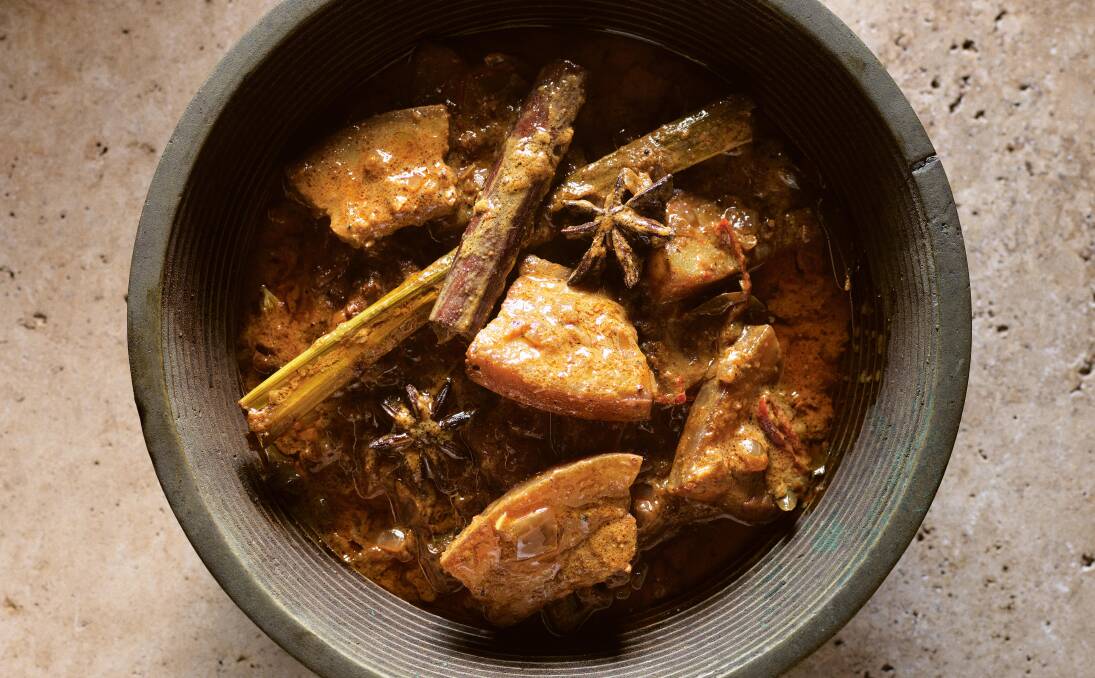
This dish is straight thievery from my mother; the recipe is almost exactly as she showed me. It all came about because of a cazuela that she bought in Spain and made me carry around the world for months. Back home it became her favourite dish to cook in, and was the reason this slightly dry pork belly curry came to be cooked in the oven. This is a rich, very slow-cooked fatty curry; the pork belly is unctuous and meltingly tender with a little sauce that is hot and a touch sweet.
Ingredients
- 1kg piece pork belly, skin on, chilled
- 30g coconut oil
- 340g diced red onion
- 2 long red chillies, finely chopped
- 20cm pandan leaf, tied into a knot
- 4g curry leaves
- 30g finely chopped garlic
- 20g finely chopped ginger
- 40g Red curry powder
- 14 cardamom pods, bruised
- 3 star anise
- 2 cinnamon quills
- salt flakes and freshly ground black pepper
- 25g tamarind concentrate
- 150ml coconut cream
Method
1. Preheat the oven to 150C.
2. Cut the pork belly into five x 1.5 cm slices and set aside. It is easier to do this when the meat is cold.
3. Melt the coconut oil in a large flameproof casserole dish or baking dish over a medium heat. Add the onion and cook for about five minutes, stirring occasionally. Add the chilli, pandan and curry leaves and continue cooking and stirring for another minute or so. Stir in the garlic and ginger, then turn up the heat before adding the curry powder and whole spices. Keep cooking until the spices darken and start to stick to the pan, about three to four minutes.
4. Add the pork and stir to coat and brown the meat for about six to eight minutes. Season with salt and pepper.
5. Mix the tamarind and 450ml water, then pour this into the dish with the pork and use a spoon to scrape the edges and the bottom of the pan. Add the coconut cream and bring to a simmer for about five minutes, then remove from heat, cover with lid or foil and place it in the oven to cook for three hours, removing it to stir a few times.
6. After three hours, turn the oven down to 110C and remove the lid or foil. By this stage, the gravy should be mostly dried out. Let the pork cook for a further 50 to 60 minutes uncovered, stirring once or twice. Once it's cooked the pork pieces will be looking nicely roasted, there will be little gravy left in the pan and the whole dish will have a lovely oiliness to it.
Serves 6-8.
Dhal
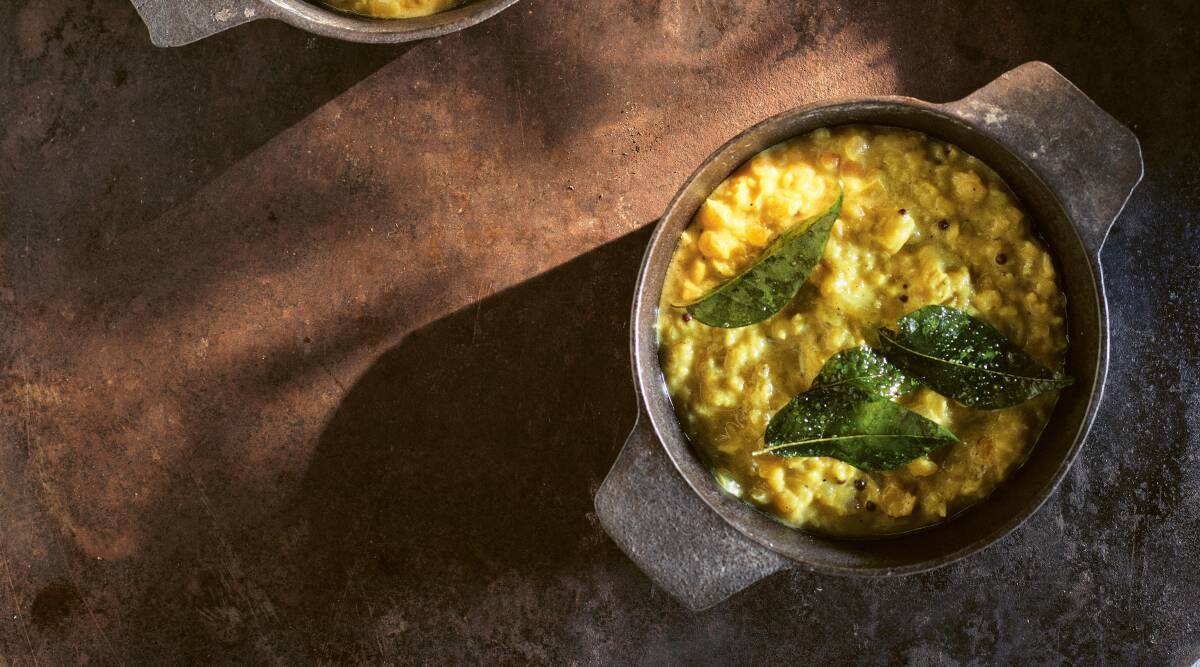
A good dhal is a thing of beauty and comfort. Cheap, nutritious and simple to make, it appears as a side to most meals, though really a bowl of rice and dhal on its own is enough to warm the heart and fill the belly. You can add a temper at the end to fancy it up a bit, or make it wetter or drier to suit your purposes. This dhal is based on the recipe my mum taught me. Creamy, mild and very savoury, this is exactly the way we cook it at Lankan Filling Station.
Ingredients
- 75g coconut oil
- 5g curry leaves
- 550g brown onions, cut into medium dice
- 18g finely chopped garlic
- 15g finely chopped ginger
- salt flakes and freshly ground black pepper
- 7g black mustard seeds
- 5g turmeric powder
- 1 cinnamon quill
- 4 x 5cm pieces pandan leaf
- bottom 5cm of 1 lemongrass stem, lightly bruised
- 525g red lentils, thoroughly washed
- 450ml coconut cream
Method
1. Melt the coconut oil in a medium saucepan over a medium heat, add the curry leaves and cook, stirring, for a minute or so until the leaves are fried. Add the onion, garlic and ginger and cook, stirring occasionally, for six to seven minutes until the onion has softened. Lightly season with salt and pepper.
2. Add the mustard seeds, turmeric and cinnamon and cook, stirring, for one to two minutes until the turmeric begins to catch on the bottom of the pan.
3. Add the pandan leaf, lemongrass and lentils and give everything a good stir to combine.
4. Pour in the coconut cream and one litre water and mix well, then reduce the heat to low and simmer gently for 10 to 15 minutes, stirring occasionally. The dhal is ready when all the lentils have just given away and turned yellow, while still retaining a little texture. Re-season with salt and pepper and serve hot.
Serves 4-6.
Milk toffee
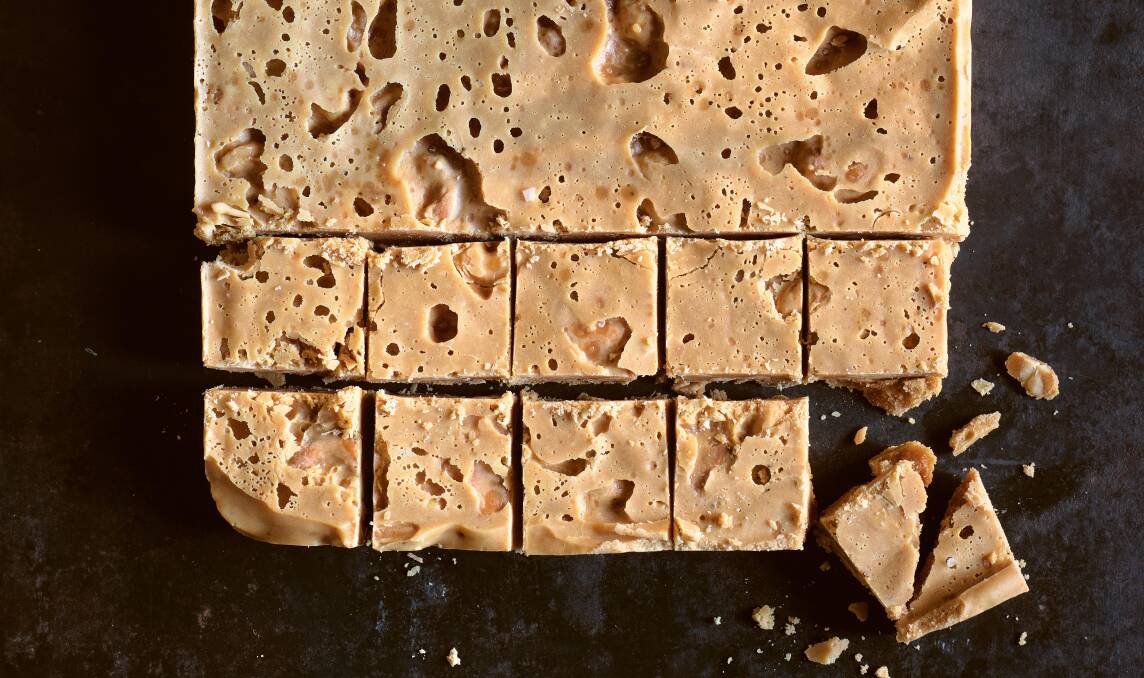
Made with condensed milk, this toffee was my favourite treat from my nan when I was a child. It is super sweet, but this version includes cashews and a little extra spice for added flavour and texture. It's not difficult to make but does need constant stirring on the stove.
Ingredients
- 200g cashews
- 2 x 395g tins condensed milk
- 400g caster (superfine) sugar
- 220g butter, diced
- 5g sweet spice mix (below)
- salt flakes
Method
1. Preheat the oven to 150C.
2. Spread out the cashews on a baking tray and toast for 15 to 20 minutes until they are uniformly pale golden, giving them a jiggle every five minutes to ensure they are cooking evenly. Set aside to cool, then very roughly chop.
3. Line a rectangular cake tin (about 28cm x 18cm) with baking paper.
4. Place the cashews, condensed milk, sugar, butter and spice mix in a wide-based saucepan and stir over a high heat until melted and combined. A wooden spoon is fine but a heatproof spatula is better.
5. Reduce the heat to low and keep stirring, gently and evenly, as it can catch very easily. It will take about 20 minutes to cook. It's ready when it darkens and you start to see patches that look a little foamy.
6. Carefully turn out the mix into the prepared tin and spread it out evenly with your spatula, gently pressing it down as you go. Tap the tin firmly on a hard surface a few times to compress the mixture a little and make it easier to cut. Finish with a nice sprinkle of salt flakes and gently press them down with the spatula.
7. Allow to cool to room temperature, then turn out the toffee slab and cut it into three cm squares. A ruler is a helpful tool here if you want to be precise. You may find that bits crumble off but that's OK. If it's too hard and crumbly it can be a sign that you have cooked it a little too much; if it doesn't set to firm, the mix is slightly undercooked.
8. Milk toffee can be stored at room temperature for up to a month, although I find it rarely lasts that long.
Makes 52 squares.
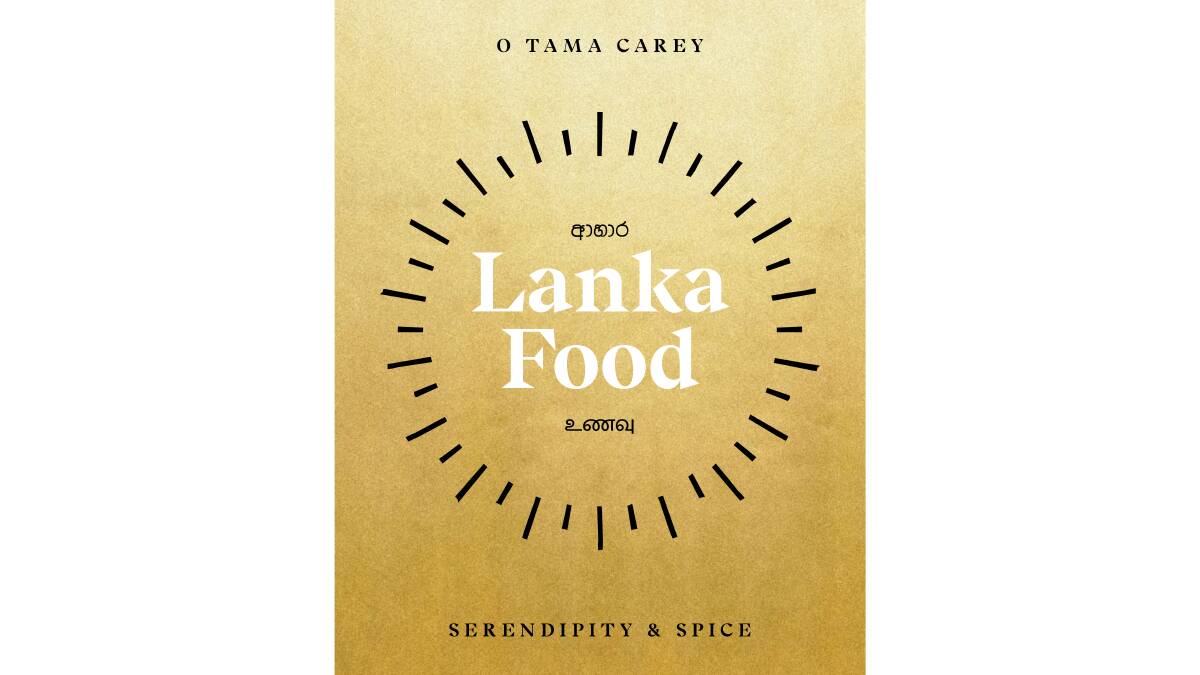
Sweet spice mix
This all-purpose mix can be used in the base of any sweet recipe that requires a little spiciness, particularly custards or poached fruit. It has quite a gentle flavour as the spices are untoasted, but the pepper does give a little heat. The salt is good for balancing out overly sweet flavours.
Ingredients
- 4g salt flakes
- 2g white peppercorns
- 2g star anise
- 2g cinnamon quill, roughly crushed
- 2g freshly grated nutmeg
- 2g cardamom seeds
- 1g whole clove (go a little under rather than over with this measure if needed)
Method
1. Combine all the spices and grind to a fine powder. Store in an airtight container.
Makes about 15g.
This is an edited extract from Lanka Food: Serendipity & Spice by O Tama Carey. Hardie Grant Books. $55.
We've made it a whole lot easier for you to have your say. Our new comment platform requires only one log-in to access articles and to join the discussion on The Canberra Times website. Find out how to register so you can enjoy civil, friendly and engaging discussions. See our moderation policy here.
Our journalists work hard to provide local, up-to-date news to the community. This is how you can continue to access our trusted content:
- Bookmark canberratimes.com.au
- Download our app
- Make sure you are signed up for our breaking and regular headlines newsletters
- Follow us on Twitter
- Follow us on Instagram

